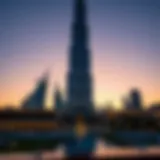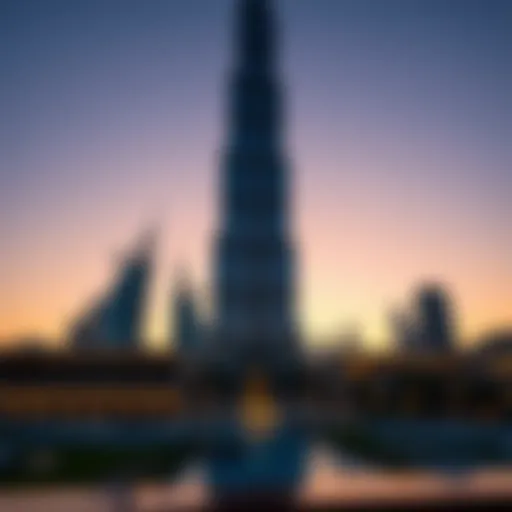Discover the Most Beautiful Gardens in Dubai
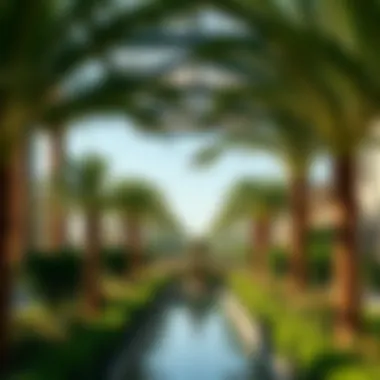

Intro
Dubai is a city where innovation meets nature, especially evident in its captivating gardens. Known for transforming arid landscapes into verdant escapes, these gardens are not just pretty places, but symbolize the city's commitment to enhancing urban living. As urban spaces continue to grow, these garden havens develop into crucial spots for connection, relaxation, and community building; they're more than just a feast for the eyes.
The allure of these gardens lies in their architectural brilliance and the diversity of flora they showcase. Each garden tells its own story through vibrant colors, unique designs, and innovative landscaping techniques, drawing both residents and tourists alike. This article promises to take you on an insightful journey through Dubai's most beautiful gardens, illuminating their significance and contributions to the well-being of the community.
As we delve deeper into the topic, we will not only highlight the gardens themselves but also explore how these lush environments foster a sense of pride, tranquility, and togetherness amongst Dubai's diverse population. In doing so, we will consider aspects like the currents trends in the real estate market and the broader implications that greenery has on property values.
By weaving together intricate descriptions and practical insights, this article aims to provide a complete understanding of how these gardens are integral to the city’s identity and lifestyle—destined to leave readers with a feeling of appreciation for these natural gems.
Preface
Overview of Dubai's Garden Culture
Dubai's garden culture is as diverse as its population. Over recent decades, the city has transformed into a vibrant hub of horticultural artistry. From stunning floral exhibitions, like those found at the Dubai Miracle Garden, to tranquil parks where families unwind, the garden scene encapsulates the essence of communal living. These gardens are not merely patches of green but reflect the city’s commitment to sustainability and environmental awareness. Since its inception, there has been an ongoing effort to blend culture and nature, which includes displaying native flora that fits the local climate.
Key Aspects of Garden Culture in Dubai:
- Diversity in Design: Each garden boasts unique themes that convey the creativity of landscape architects, ranging from traditional Arabian designs to contemporary layouts.
- Community Engagement: Events hosted in these gardens often foster community bonds, bringing together people from various backgrounds and cultures.
- Education and Awareness: Many gardens are focal points for educational programs aimed at teaching the importance of biodiversity and sustainable gardening practices.
It's noteworthy that these green spaces are not just for show; they are crucial to the well-being and happiness of the city's residents.
Importance of Green Spaces in Urban Settings
In urban settings like Dubai, green spaces play an instrumental role in creating a balanced environment. The presence of parks and gardens enhances the overall quality of life, enabling individuals to engage with nature amidst their busy schedules.
Immediate Benefits of Urban Green Spaces Include:
- Air Quality Improvement: Plants absorb pollutants and produce oxygen, leading to cleaner air.
- Mental Health Boost: Nature has a calming effect, reducing stress and promoting well-being through serene settings.
- Social Interaction Space: Parks serve as social hubs where individuals from diverse backgrounds can come together, fostering community spirit.
According to studies, cities that prioritize greenery often see residents exhibiting higher overall satisfaction with their living environment. This is particularly significant in a place like Dubai, where the contrast between the urban sprawl and natural beauty becomes a vital psychological escape for many.
"The pursuit of happiness is the true wealth of a city; green spaces are the heartbeats that nurture this wealth."
As investors, expatriates, and homeowners seek a lifestyle rich with opportunities in Dubai, the significance of these gardens as essential elements of urban development becomes clear. The persistent commitment to enhancing these green spaces reflects the larger vision of creating a sustainable future for all who call Dubai home.
Dubai Miracle Garden
The Dubai Miracle Garden stands as a testament to human creativity and the resilience of nature, making it a crucial focal point in any discussion about the lush gardens embellishing Dubai. This garden is not merely a sanctuary for flora but also a vibrant display of artistry, transforming the arid landscape into an oasis that whispers, "Look what we can achieve." The sheer magnitude of floral arrangements here captivates both residents and visitors alike, allowing them to step into a realm where color and fragrance collide.
Design and Flower Displays
At first glance, the design of the Dubai Miracle Garden is nothing short of spectacular. Spanning over 72,000 square meters, this garden showcases an astounding variety of over 50 million flowers, all meticulously arranged into stunning patterns and shapes. From cascading waterfalls of blossoms to heart-shaped pathways, each corner of the garden evokes a sense of wonder. The innovative designs often draw themes from popular culture as well, such as life-sized houses made entirely of flowers or replicas of famous landmarks. This blend of creativity and nature is what pulls many to marvel at this floral wonderland. The colorful bloom displays transform with the seasons, ensuring that there’s always a fresh spectacle to behold.
Unique Features and Attractions
What sets the Dubai Miracle Garden apart is its array of unique features and attractions that entice visitors from near and far. A standout within the garden is the Butterfly Garden, which houses over 15,000 butterflies, providing an enchanting experience for guests.
In addition, the changing flower displays throughout the year keep the garden looking like a fresh canvas, with new installations that can include ambitious structures like flower-covered cars or massive sculptures. It's occasionally used for events showcasing both local and international art, which encourages community engagement and appreciation for nature as well as human ingenuity.
"The Dubai Miracle Garden is less a garden and more a canvas painted with petals and leaves, capturing the essence of what a garden can be."
Visiting the garden in the early morning hours provides an even more intimate experience. The gentle rustling of leaves, the lively songs of various birds, and the soft colors of dawn create a backdrop that’s both tranquil and alive. Amenities such as cafes scattered through the garden offer refreshment, allowing guests to indulge while surrounded by beauty.
The holiday season often brings its own magic to the garden with festive decorations that complement the floral aesthetics. This captivating fusion of nature and creativity not only delights the senses but also serves as a boost to tourism and the local economy. These aspects underscore the importance of the Dubai Miracle Garden as more than just an attraction, but as a vital part of the cultural and ecological tapestry of Dubai.
Al Barsha Pond Park
Al Barsha Pond Park is a serene jewel nestled in the bustling heart of Dubai. With its expansive 50-hectare area, it offers a refreshing escape for both residents and visitors alike. This park stands out not only for its vast green spaces but also for its particular focus on fostering community interaction and promoting a healthy lifestyle. As urban areas become increasingly crowded and demand for sustainable living spaces rises, parks like Al Barsha become vital for enhancing quality of life.
Natural Landscaping Elements
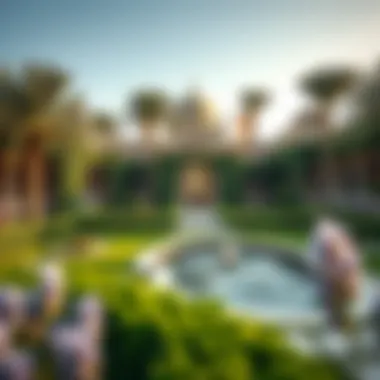

At first glance, Al Barsha Pond Park captivates the senses with its meticulously planned landscape. Walking through the park, one notices a delightful blend of natural features and artistic design. A large pond, serving as the park's centerpiece, provides a habitat for various birds and reflects the surrounding palm trees and flowering plants.
The park is lined with paths that meander through diverse flora, including vibrant bougainvillea and shade-giving trees like the ghaf. The landscaping incorporates local species, which not only support the ecosystem but also require less water — an essential consideration in a city where sustainability is becoming paramount. Walking paths, cycling tracks, and shaded seating areas allow visitors to enjoy both the beauty and the tranquility of the surroundings. This connection to nature fosters an appreciation for the environment that is often lost in urban settings.
Community and Recreational Opportunities
Al Barsha Pond Park is not just a beautiful location; it is a hub for community and social activities. People of all ages gather here, engaging in various recreational pursuits. The park features wide paths designed for walking and cycling, encouraging a healthy lifestyle. Joggers can often be seen at dawn or dusk, taking advantage of the cooler temperatures.
The park also offers play areas for children, where families bond over fun and games. Additionally, the multi-purpose sports areas attract those who enjoy team sports or fitness routines in open air. With picnic areas scattered throughout, groups can make a day of enjoying the park — meals shared under the shade of trees become bonding experiences.
Activities aren’t limited to physical fitness; the park hosts community events and festivals which can range from outdoor yoga classes to cultural celebrations. These gatherings not only increase social interaction but also enrich the community’s cultural fabric.
In summary, Al Barsha Pond Park exemplifies the beauty of integrating nature within urban frameworks, making it a cornerstone for community spirit and lifestyle in Dubai. As more people flock to the city for its opportunities, parks like Al Barsha remind residents of the importance of green spaces — a sanctuary amidst the urban rush.
"Green spaces are not just aesthetics; they are essential for well-being and community ties."
In fact, Al Barsha Pond Park demonstrates how thoughtful design can enhance urban life significantly, appealing to various demographics from families to fitness enthusiasts. As Dubai continues its journey toward sustainability, spaces like Al Barsha will be key in nurturing a thriving community.
Safa Park
Safa Park is a gem tucked away in the bustling heart of Dubai. Positioned strategically between Al Wasl Road and Sheikh Zayed Road, this verdant oasis boasts not only the charm of nature but also plays a vital role in the urban landscape of Dubai. Its significance stretches beyond mere aesthetics; it serves as a community hub fostering social interaction, relaxation, and outdoor activities for both residents and visitors. The park's design, aligning with community well-being, is a testament to Dubai's commitment to creating green spaces that enhance livability.
Historical Background
Safa Park is not just a patch of grass; it has a story. Established in the late 1970s, the park was initially designed to introduce nature into the desert environment of Dubai. Originally, it focused on cultivating the region’s native flora and creating a space where people could escape the fast pace of city life. Over the years, it has undergone several renovations that modernized its facilities while respecting its roots. This commitment to maintaining its essence while adapting to contemporary needs signifies Dubai’s effort to balance tradition and innovation in urban development. Nowadays, visitors can spot remnants of its history amidst the modern architecture and recreational areas, providing a rich backdrop that captures the transformation of Dubai itself.
Activities and Amenities Available
At Safa Park, the offerings are as vibrant as its flowerbeds. It is a playground for all ages, featuring a variety of amenities that cater to a wide range of interests. The park possesses extensive walking and jogging paths that meander through meticulously manicured gardens, encouraging a healthy lifestyle. Additionally, there are picnic areas equipped with grills, ideal for family gatherings or leisurely outings with friends.
- Children's Play Areas: Safa Park includes several play zones that inspire joy among the little ones. From climbing structures to swing sets, kids can burn off energy while parents unwind nearby.
- Sporting Facilities: For the active crowd, there are basketball courts and cricket fields, where enthusiasts can engage in friendly matches.
- Cafés and Refreshments: As you stroll through, you will come across scattered cafés perfect for grabbing a drink or a quick bite.
- Event Spaces: The park also periodically hosts cultural events and activities, bringing the community together to celebrate local traditions.
Overall, Safa Park is a synthesis of recreational, communal, and ecological values, embodying an essential resource for urban dwellers and setting an example of how nature and city living can harmoniously coexist.
"In the heart of Dubai lies the lush Safa Park, a testimony of the city’s dedication to sustainability and community spirit."
As Dubai continues to grow, parks like Safa will remain significant, not just for their beauty, but for the lifestyle they promote.
Zabeel Park
Zabeel Park is often overlooked when discussing Dubai's lush gardening scene, yet it holds a distinct significance in the city’s green landscape. Situated in the heart of Dubai, the park serves as a refreshing retreat for residents and tourists alike, illustrating the city’s commitment to incorporating nature into urban life. It is not merely a botanical display but a multifunctional space that enhances both leisure and community connectivity.
Innovative Design and Structures
Zabeel Park is an architectural marvel, showcasing innovative design principles that harmonize nature with urban infrastructure. The park is segmented into two levels, ensuring that visitors can either stroll along the ground or ascend to higher viewpoints for broader vistas of the Dubai skyline. These vantage points are not only aesthetically pleasing but also serve a functional purpose, allowing guests to appreciate the engineering prowess of the surrounding skyscrapers.
One of the standout structures is the Dubai Frame, which towers above the park, offering a unique perspective on both the old and new Dubai. This structure acts as both a gallery and a photo op, drawing crowds eager to capture the juxtaposition of the city’s past and present. The lush greenery of Zabeel Park juxtaposed against the modern skyline creates a visually striking environment, attracting photographers and nature lovers alike.
Another feature that embodies innovation is the use of sustainable materials and eco-friendly practices in landscaping. The park includes solar energy panels and intelligent irrigation systems, minimizing water waste and ensuring that the flora thrives. This approach not only champions sustainability but serves as an educational tool for visitors to learn about environmental responsibility.
Cultural and Educational Programs Offered
Beyond its serene landscapes, Zabeel Park is dedicated to enriching community life through various cultural and educational initiatives. The park regularly hosts workshops, art exhibitions, and environmental talks aimed at both children and adults. For instance, activities centered around understanding native plant species encourage citizens to get involved in local conservation efforts.
Family-friendly events, such as outdoor movie nights and seasonal festivals, also draw crowds, creating a sense of community bonding. For those curious about gardening or urban farming, Zabeel Park offers hands-on programs where participants can learn the ropes of planting and caring for their own gardens.
"A garden is not just a place to grow plants; it's a community space nurturing relationships and environmental awareness."
Visitors can also engage with local artists and artisans through pop-up markets that occur regularly, transforming the park into a cultural hub. This emphasis on education and community involvement ensures that Zabeel Park is not just a green space but a vibrant part of Dubai’s social fabric, inviting citizens and visitors to be part of something greater.
Dubai Creek Park
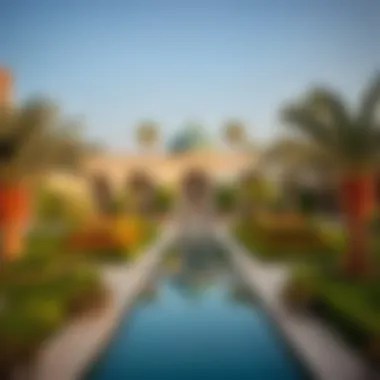

Dubai Creek Park stands as a gem in the tapestry of Dubai's urban landscape. Its strategic location along the historic Dubai Creek makes it not just a park, but a vital part of the city’s cultural identity. This verdant enclave offers a unique blend of natural beauty, recreational activities, and a serene environment, appealing to both residents and visitors. As green spaces like Dubai Creek Park promote well-being and social interactions, they further enhance the city's allure, supporting the notion that lush surroundings contribute significantly to urban living.
Flora and Fauna: A Closer Look
When you step into Dubai Creek Park, you're not merely walking into a garden; you’re entering a realm where diverse flora and fauna come together harmoniously. The park boasts over 400 species of trees and plants, with an emphasis on local and indigenous species. This showcases not only the area's natural biodiversity but also supports local wildlife, including various bird species, which find refuge here.
Interestingly, the park features an array of plants adapted to thrive in Dubai's arid climate. From the beautiful Ghaf tree to vibrant bougainvillea, these plants provide a refreshing splash of color and play a critical role in maintaining the ecosystem.
Moreover, birds like the flamingo can occasionally be spotted near the creek, making it a birdwatchers' paradise. Here, enthusiasts may find more than than just looks; they can immerse themselves in nature’s symphony, listening to birds singing while gazing at the lush greenery.
Recreational Activities for Visitors
Dubai Creek Park isn't just a feast for the eyes; it also serves as a hub for recreation and community engagement.
- Picnic Areas: Families frequently gather in the dedicated picnic spots, where they can enjoy a meal amidst nature.
- Children’s Play Areas: There are well-equipped play zones for children to run wild and unleash their energy.
- Bike Rentals: The park offers bike rentals for those who prefer exploring on wheels. It’s a great way to cover more ground while enjoying the fresh air.
- Cultural Events: The park’s spacious layout allows for cultural events and activities throughout the year, fostering community spirit.
The blend of open space and well-maintained pathways encourages physical activity, whether it’s jogging, cycling, or leisurely strolls.
The Green Planet
In the heart of Dubai, The Green Planet stands as a testament to the harmonious coexistence of nature and urban life. This indoor rainforest is not just a leisure destination; it embodies a crucial narrative in Dubai's green initiatives and much broader ecological efforts. By showcasing a variety of plant life and ecosystems from around the world, it emphasizes the city's commitment to sustainability and environmental education, making it an important landmark in this article.
Concept and Purpose
The Green Planet is designed as an immersive experience that draws visitors into a lush ecosystem, far removed from the arid deserts that characterize much of the UAE. The concept is built around the idea of education, engagement, and a deep appreciation for nature. Inside, the temperature is controlled, fostering an environment where over 3,000 species of plants and animals thrive.
The primary purpose of The Green Planet is to educate the populace about biodiversity and conservation. It serves as an interactive space where people can learn about tropical ecosystems, the importance of various species, and how they contribute to environmental health. Additionally, it aims to encourage behaviors that promote sustainability, guiding visitors to understand their role in preserving the planet.
Unique Biomes and Ecosystems
What sets The Green Planet apart is its carefully planned biomes, each resembling a unique aspect of global ecosystems.
- Rainforest: The central feature, this area is home to exotic trees and numerous animal species, providing a habitat that mirrors the world’s tropical climates.
- Desert Zone: A nod to the local environment, it showcases how life adapts to extreme conditions. Cacti and other drought-resistant flora populate this section.
- Coral Reef: Featuring an aquarium that presents vibrant marine life, this biome emphasizes the delicate balance of underwater ecosystems and highlights ongoing conservation efforts.
Notably, each biome fosters interaction and learning experiences. Visitors can engage with the flora and fauna directly through guided tours or informational exhibits, making it more than just a passive viewing experience.
"The Green Planet brings nature to Dubai's urban landscape, offering visitors an opportunity to connect with the beauty of our planet's ecosystems."
Ras Al Khor Wildlife Sanctuary
The Ras Al Khor Wildlife Sanctuary stands as a vital component in the ecosystem of Dubai. Known for its breathtaking beauty, the sanctuary serves multiple roles—from being a refuge for wildlife to acting as a natural filter for pollution in urban areas. Spanning over 6.2 square kilometers, it is one of the few protected areas within the city, making it an important area for both conservation and education. Here, visitors get a chance to experience untouched nature amidst a rapidly developing urban landscape, highlighting the significance of preserving green spaces in a bustling city.
Biodiversity and Conservation Efforts
One of the most remarkable features of Ras Al Khor is its rich biodiversity. The sanctuary is home to more than 450 species of wildlife, including migratory birds, fish, and various terrestrial creatures. The flamingos, often considered the sanctuary's signature residents, gather in large numbers during winter months, painting the landscape with vibrant pink hues. Besides these flamboyant birds, one can also spot herons, ibises, and a host of other avian species.
The conservation efforts here are noteworthy as well.
- Habitat Protection: The sanctuary protects both marine and coastal habitats, ensuring a balanced ecosystem.
- Research Initiatives: Collaborative studies help monitor species and improve conservation strategies.
- Sustainability Programs: Energy-efficient measures and waste management practices are being implemented to minimize human impact.
Efforts by the Dubai Wildlife Conservation Team have been essential in maintaining and improving habitats, thereby ensuring the sanctuary continues to thrive.
Visitor Engagement and Awareness Programs
Engaging the local community and tourists is crucial for fostering a love for nature and wildlife conservation. Ras Al Khor Wildlife Sanctuary offers several educational programs designed to inspire and inform visitors about its diverse habitats and wildlife. These initiatives are critical in promoting environmental consciousness.
- Guided Tours: Knowledgeable guides lead small groups through the sanctuary, explaining the ecology and significance of various species.
- Workshops and Events: Regularly organized workshops aimed at schools and families focus on environmental stewardship, birdwatching, and photography.
- Interactive Exhibits: On-site exhibits provide informative insights into the wildlife species and sustainability efforts.
Through these programs, both residents and visitors gain an appreciation for the sanctuary's ecological importance. > "The Ras Al Khor Wildlife Sanctuary is not just a resting point for birds but a living classroom for conservation education."
Ras Al Khor Wildlife Sanctuary is an example of how urban development can coexist with nature. Revitalizing communities and welcoming tourists, this sanctuary stands as a testament to humanity's capacity to protect and cherish nature amidst modernization.
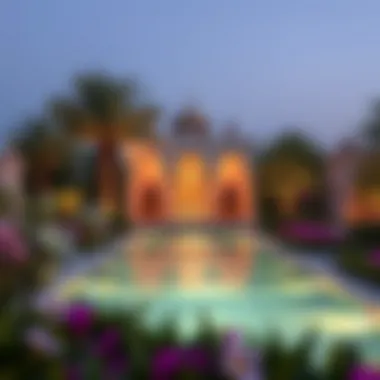

Community Gardens
Community gardens in Dubai stand as vibrant testaments to the power of collaboration, showcasing how lush spaces can transform not just landscapes but lives too. They serve as essential components in the broader narrative surrounding urban greenery, highlighting the vital benefits they bring to local populations.
Promoting Local Agriculture
One of the most significant contributions of community gardens is their role in promoting local agriculture. Unlike commercial farms that might overlook native plant species, community gardens focus on cultivating a variety of edible plants, from traditional herbs to local fruits and vegetables. This practice not only encourages sustainable agricultural practices but also enables residents to reconnect with the source of their food. It’s remarkable how these gardens support biodiversity while lowering the carbon footprint associated with importing produce.
No doubt, with Dubai’s rapidly growing population, community gardens address food security concerns head-on. With the prevalence of urban sprawl, having localized sources for fresh produce can lead to healthier diets and improved well-being. And in all honesty, the satisfaction of picking your own tomatoes or herbs cannot be overstated.
Moreover, engaging in these gardening activities can foster knowledge sharing among residents. New gardeners often learn from seasoned ones, creating an organic exchange of tips and advice that transcends age and cultural backgrounds. That exchange can blossom friendships, support networks, and a sense of belonging within the community.
Building Community Bonds Through Gardening
Gardening is often seen as a solitary activity, yet community gardens flip that notion on its head. They are communal spaces where individuals gather, sharing not just tips on gardening, but stories, experiences, and laughter. This social interaction nurtures a sense of community spirit, effectively combating the isolation that can be felt in urban settings.
In many cases, these gardens serve as gathering places, offering workshops, farmers' markets, or educational sessions that engage the broader community. Consider how many people might come together to learn about urban composting or pollinator plants—activities that not only enrich knowledge but weave tight-knit bonds among participants.
"Community gardens do more than beautify a neighborhood; they bring people together, fostering connections among strangers and neighbors alike."
Another compelling aspect is their ability to bridge generational gaps. Children learn about nature and responsibility, while older residents find their skills cherished—like passing down family recipes that rely on homegrown ingredients. It’s a full-circle moment that enhances community cohesion and understanding.
In summary, community gardens are not merely patches of green in an otherwise urbanized landscape. They encapsulate the ideals of sustainability, collective effort, and community connection, further enriching Dubai's already diverse urban culture. As Dubai forges ahead, these gardens may very well become central hubs in the cities of tomorrow.
Future of Green Spaces in Dubai
The future of green spaces in Dubai is not just a passing trend; it's an essential part of the city’s evolution. With rapid urbanization, the need for vibrant ecological environments has never been more pressing. This section delves into why the enhancement of these spaces is key to improving quality of life and fostering community involvement in an ever-expanding landscape. Green areas play a pivotal role in cooling urban heat islands, contributing to biodiversity, and enhancing the mental well-being of residents. Furthermore, these spaces act as a unifying force, bridging gaps between diverse cultures residing in Dubai.
Urban Planning and Sustainability Initiatives
Urban planning initiatives in Dubai have put green spaces at the forefront of their agendas. The city's approach to creating an integrated and sustainable environment is commendable. Notably, the Dubai Urban Master Plan emphasizes the importance of parks and gardens in urban settings.
- Sustainable Urban Design: New developments are incorporating green roofs and vertical gardens, reducing concrete surfaces that retain heat. This not only minimizes energy consumption in buildings but also enhances aesthetic appeal.
- Smart Parks: Some parks are being equipped with smart technologies, like environmental sensors to monitor plant health and air quality. This data makes it easier for city planners to manage green resources effectively.
- Community Engagement: Initiatives that involve residents in the upkeep of parks not only foster a sense of ownership but also encourage educational programs about the environment.
A notable example is the Dubai Parks and Resorts initiative, which integrates natural landscapes within recreational facilities, emphasizing how crucial green space is in urban life.
Vision for Future Parks and Gardens
Looking ahead, the vision for Dubai’s parks and gardens reflects a commitment to innovation and community enrichment. The goal is to create multi-functional spaces that suit various activities while being eco-friendly.
- Integrative Design: Future parks are expected to offer more than just green space. Plans are in place for parks that include sports facilities, art installations, playgrounds, and even spaces for community events. These multifunctional areas are designed to cater to a diverse population.
- Biodiversity Promotion: There is a growing awareness of native plant species and their importance in maintaining local ecosystems. Parks will likely include more flora that supports local wildlife, enhancing biodiversity.
- Access and Mobility: Ongoing projects are focused on making parks accessible to all, with improved pathways and transportation options for pedestrians and cyclists.
"To improve quality of life in urban areas, embracing nature must go beyond aesthetics; it should be woven into the fabric of the city’s development."
In summary, the future of green spaces in Dubai is being shaped by visionary planning and sustainability initiatives that prioritize ecological integrity, community involvement, and multifunctional design. As these projects come to fruition, they will not only transform the city landscape but also create a much-needed balance between urban living and nature, ultimately enriching the lives of residents and visitors alike.
End
The gardens of Dubai are not mere patches of greenery; they are lifelines for the urban landscape and reflections of a city that thrives on innovation and sustainability. As we conclude this exploration, it’s vital to understand the multi-faceted significance these green spaces hold.
Reflecting on Dubai's Garden Essence
The essence of Dubai’s gardens is one that entwines nature with community, aesthetics with functionality. Each garden, unique in its design, contributes to the intricate tapestry of urban life. By providing places of respite amid concrete structures, they encourage a lifestyle that prioritizes mental well-being and social interaction.
Moreover, these gardens serve as showcases for environmental sustainability efforts, aptly blending beauty with ecological awareness. Consider the transformative role Dubai Miracle Garden plays every season, drawing over a million visitors who marvel at the elaborate floral displays and artistic shapes crafted entirely from flowers.
Key reasons why Dubai's gardens hold significance:
- Cultural Spaces: Gardens act as venues for local events, fostering a sense of community and promoting cultural heritage.
- Environmental Benefits: They aid in reducing urban temperatures and supporting biodiversity, serving as habitats for various species.
- Aesthetic Appeal: The meticulously designed landscapes reflect the Arabian culture while enhancing property values within their vicinity.
"Gardens are not just places to visit; they are portals to peace and sustainability."
Thus, as one takes a stroll through these stunning landscapes, it becomes apparent that they are fundamental to not just the environment but also to the essence of life in Dubai.
Relevant Resources
- Dubai Garden Landscape and Design
- Urban Sustainability Initiatives in Dubai
- Community Gardening in Urban Regions
- Benefits of Urban Green Spaces
As the city forges ahead, it is clear that its gardens will remain as quintessential elements of Dubai’s ongoing narrative in urban ecology and community lifestyle.


